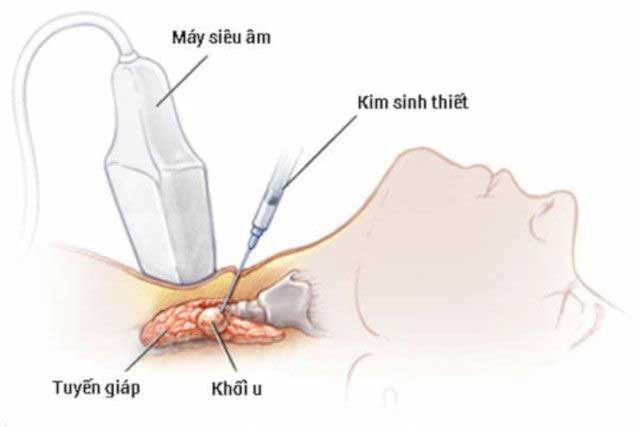Signs that indicate you need a thyroid ultrasound
The article is professionally consulted by Master, Doctor Nguyen Thi Ngoc - General Internal Medicine - Endocrinology - Department of Examination & Internal Medicine - Vinmec Central Park International General Hospital.
The thyroid gland is an organ with many diseases and serious health effects, especially in women. Thyroid ultrasound is currently one of the most common examinations in the general health monitoring program.
1. What is a thyroid ultrasound?
The thyroid gland is the largest and most important endocrine gland in the body located at the front of the neck, shaped like a butterfly, with 2 lobes right and left, secreting the hormones thyroxine (T4) and triiodothyronine (T3), receiving regulatory influence of TSH hormone from the pituitary gland on the brain as well as T4/T3 has the function of regulating many metabolism in the body.
Thyroid ultrasound is an examination method to visualize the thyroid structure by ultrasound to examine the normal thyroid gland as well as detect lesions in the thyroid gland, and at the same time survey the parathyroid gland lesions and other groups. involved nodes, if any.
Thyroid tissue elasticity ultrasound is an ultrasound technique that evaluates the stiffness of the tissue through the degree of elasticity of the tissue when subjected to mechanical force, a new method in the early diagnosis of thyroid cancer. Pathological tissues with the same echogenicity, on B-mode ultrasound images, it is difficult to distinguish benign or malignant properties, Doppler ultrasound can further support the diagnosis, malignant tumors often proliferate blood vessels. Therefore, elastography of thyroid tissue will help to add more information about the characteristics of the damaged tissue to increase the diagnostic ability.
Thyroid ultrasound is an examination method to visualize the thyroid structure by ultrasound to examine the normal thyroid gland as well as detect lesions in the thyroid gland, and at the same time survey the parathyroid gland lesions and other groups. involved nodes, if any.
Thyroid tissue elasticity ultrasound is an ultrasound technique that evaluates the stiffness of the tissue through the degree of elasticity of the tissue when subjected to mechanical force, a new method in the early diagnosis of thyroid cancer. Pathological tissues with the same echogenicity, on B-mode ultrasound images, it is difficult to distinguish benign or malignant properties, Doppler ultrasound can further support the diagnosis, malignant tumors often proliferate blood vessels. Therefore, elastography of thyroid tissue will help to add more information about the characteristics of the damaged tissue to increase the diagnostic ability.

Hình ảnh siêu âm tuyến giáp
2. Indications for thyroid ultrasound
Screening people at high risk for thyroid cancer such as history of external radiation therapy in children, family history of medullary thyroid cancer, personal or family history of Graves' disease or familial polyposis , calcitonine concentration increased 2 times, evaluate thyroid damage when clinically detected including all cases with clinical signs of thyroid disease: Thyroiditis, dysfunction, abnormal lymph nodes neck area. Periodic monitoring of thyroid lesions, after thyroid surgery. Locating interventions to diagnose and treat thyroid lesions (fine needle aspiration, aspiration of thyroid follicles...).
According to Dr. Ngoc, this section is structured as follows:
- Detects solitary nodule, multinodular goiter, thyroiditis, thyroid dysfunction (hyperthyroidism, hypothyroidism) during thyroid examination; Periodic monitoring of thyroid lesions mentioned above.
- Suspected thyroid nodule in patient with difficult thyroid examination
- History of neck radiotherapy
- Family history: medullary thyroid cancer, multiple endocrine neoplasia type 2 (a hereditary condition associated with combination of 3 primary cancers (thyroid medullary cancer, parathyroid cancer, and adrenal medullary cancer) or papillary cell carcinoma of the thyroid
- Unexplained cervical lymphadenopathy
- Before surgery thyroidectomy for thyroid cancer, fine needle aspiration cytology - thyroid FNA; Long-term follow-up after thyroidectomy
According to Dr. Ngoc, this section is structured as follows:
- Detects solitary nodule, multinodular goiter, thyroiditis, thyroid dysfunction (hyperthyroidism, hypothyroidism) during thyroid examination; Periodic monitoring of thyroid lesions mentioned above.
- Suspected thyroid nodule in patient with difficult thyroid examination
- History of neck radiotherapy
- Family history: medullary thyroid cancer, multiple endocrine neoplasia type 2 (a hereditary condition associated with combination of 3 primary cancers (thyroid medullary cancer, parathyroid cancer, and adrenal medullary cancer) or papillary cell carcinoma of the thyroid
- Unexplained cervical lymphadenopathy
- Before surgery thyroidectomy for thyroid cancer, fine needle aspiration cytology - thyroid FNA; Long-term follow-up after thyroidectomy
3. Thyroid ultrasound technical procedure
First, the patient lies on his back, puts a pillow under his shoulder, and lifts his head high, tilts back, hands down to expose the area that needs thyroid ultrasound. Remove jewelry if present.
The sonographer moves the transducer at a moderate speed, with continuous slices and scans in a cross-sectional plane, cutting along the thyroid axis to examine the entire lobes, isthmus and groups neighboring nodes.
When the doctor detects diffuse lesions, determine the length, width, thyroid thickness, and isthmus thickness, the acoustic structure compares with the adjacent muscle group and use color Doppler and Doppler energy assessment of angiogenesis.
The sonographer moves the transducer at a moderate speed, with continuous slices and scans in a cross-sectional plane, cutting along the thyroid axis to examine the entire lobes, isthmus and groups neighboring nodes.
When the doctor detects diffuse lesions, determine the length, width, thyroid thickness, and isthmus thickness, the acoustic structure compares with the adjacent muscle group and use color Doppler and Doppler energy assessment of angiogenesis.

Bất thường tại vùng tuyến giáp
When detecting a focal lesion, it is necessary to perform different slices to determine: Location, number of lesions and then map the lesion, shape, contour of the lesion, measure the size in 3 dimensions, at least must measure the major axis anteroposterior and horizontal axis right and left with description of the lesion structure such as hyperechoic, hypoechoic, homonymous, calcified in the lesion as well as characteristics of the lesion area including acoustic drum, calcified septum in the lesion. , hypoechoic, homonymous, hyperechoic, or calcified in lesions. Identify the group of cervical lymph nodes, if any. Color Doppler and Power Doppler to evaluate central or mixed central and peripheral angiogenesis. Lesions that need to be ruled out for thyroid malignancy are when the nodules are >2cm in size or <2cm in high-risk people or show clinical signs, thyroid cysts account for more than 25% of the tissue. Thyroid nodules have at least 2 signs such as solid and hypoechoic nodules, scattered small calcifications, unclear borders and boundaries, mass-height larger than width, mixed vascularization.
When detecting lymph node involvement, it is necessary to determine the site of mapping, size, morphology and structure of lymph nodes
When detecting lymph node involvement, it is necessary to determine the site of mapping, size, morphology and structure of lymph nodes
4. Benefits of Thyroid Ultrasound

Sinh thiết kim và chọc hút dịch dưới sự hỗ trợ của siêu âm
Thyroid ultrasound is a needleless, painless technique that is easy to apply and less expensive than other methods. Ultrasound produces clear, true soft tissue images, is safe, does not contain ionizing radiation, and is also a good tool for guiding minimally invasive procedures such as needle biopsies and aspiration aspiration.
The thyroid gland is in a position that is easy to check and some diseases can be detected with the naked eye. Thyroid ultrasound should be examined during the general physical examination and indicated when the clinician examines the neck for suspicion of a neck tumor, a goiter (goiter), an intramediastinal mass, or when Clinical examination is normal but thyroid disease is suspected on laboratory tests.
Thyroid gland has many important functions and thyroid ultrasound is done easily and quickly, giving accurate results. Periodic examination and follow-up is recommended to detect pathological conditions and timely remedy, ensuring keep yourself and your family healthy.
To register for examination and treatment at Vinmec International General Hospital, you can contact Vinmec Health System nationwide, or register for an online examination HERE
MORE
Diagnosis of hypothyroidism by radiation Thyroid imaging Common thyroid diseases Role of thyroid scintigraphy in the diagnosis of thyroid diseases
The thyroid gland is in a position that is easy to check and some diseases can be detected with the naked eye. Thyroid ultrasound should be examined during the general physical examination and indicated when the clinician examines the neck for suspicion of a neck tumor, a goiter (goiter), an intramediastinal mass, or when Clinical examination is normal but thyroid disease is suspected on laboratory tests.
Thyroid gland has many important functions and thyroid ultrasound is done easily and quickly, giving accurate results. Periodic examination and follow-up is recommended to detect pathological conditions and timely remedy, ensuring keep yourself and your family healthy.
To register for examination and treatment at Vinmec International General Hospital, you can contact Vinmec Health System nationwide, or register for an online examination HERE
MORE
Diagnosis of hypothyroidism by radiation Thyroid imaging Common thyroid diseases Role of thyroid scintigraphy in the diagnosis of thyroid diseases
Bài viết này được viết cho người đọc tại Sài Gòn, Hà Nội, Hồ Chí Minh, Phú Quốc, Nha Trang, Hạ Long, Hải Phòng, Đà Nẵng.






